Cutting metal roofing is an essential skill for any DIY enthusiast or professional in the construction industry. Get it right and you’ve got a durable, weather-resistant surface that will stand the test of time; get it wrong and you’re left with a leaky roof, wasted materials, and potential injuries. In this blog post, you’ll learn how to cut metal roofing like a pro, regardless of your experience level. We’ll cover the right tools for the job, preparing your workspace, safety measures, and step-by-step cutting techniques that will have you cutting metal roofing with confidence in no time.
Table of Contents
ToggleShort Summary
- Choose the right tools for cutting metal roofing, such as tin snips, circular saws, angle grinders and power shears.
- Prepare workspace and measure/mark sheets accurately to ensure precise cuts with minimal material waste.
- Follow safety measures when cutting metal roofing panels including wearing protective gear and adopting safe techniques.
Choosing the Right Tools for Cutting Metal Roofing
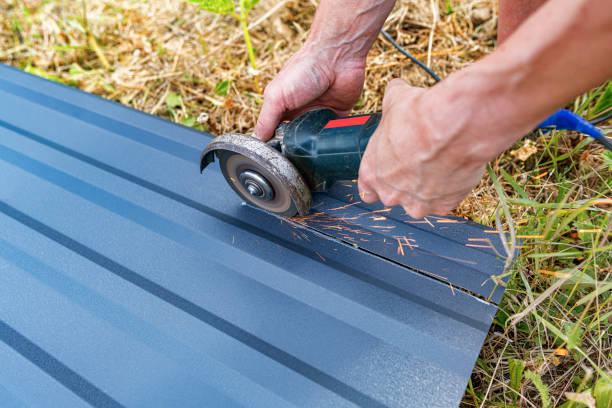
As with any task, using the right tools is crucial for cutting metal roofing efficiently and safely. There are a few different tools you can use, depending on the type and thickness of the metal, as well as the nature of the cut you need to make. In this section, we will introduce four main tools that are commonly used for cutting metal roofing.
- Tin snips
- Circular saws
- Angle grinders
- Power shears
Each tool has its own strengths and weaknesses, so it’s essential to choose the right one for your specific metal cutting needs.
Tin snips are perfect for precision cuts, especially for short and curved cuts on individual metal sheets. Circular saws are ideal for making straight and long cuts on metal roofing panels, ensuring accuracy and efficiency. Angle grinders are versatile cutting tools that can be used for various cutting tasks, including cutting metal roofing, bolts, and rebar. Power shears are fast and efficient tools for cutting metal roofing, especially when working with multiple sheets.
In the following subsections, we will discuss each of these tools in more detail.
Tin Snips: Precision Cuts
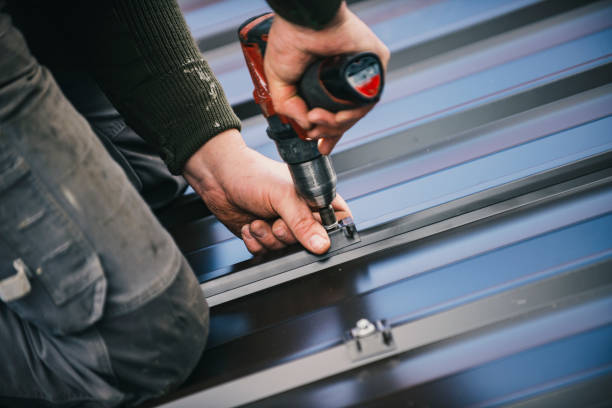
Tin snips are manual cutting tools that are well-suited for making precise, short cuts on individual metal sheets. They can be used for cutting various types of metal roofing, including aluminum and copper, and are particularly useful for cutting sheet metal, gutters, and studs. There are different types of tin snips available, each designed for specific cutting tasks. Yellow or plain-tip snips are used for cutting straight lines on corrugated metal, while left-handed snips are designed to cut counterclockwise, enabling rounded cuts to the left. Right-handed snips are designed to cut clockwise. This enables rounded cuts to the right.
Tin snips are advantageous for precise cuts, particularly for short and curved cuts on individual metal sheets. Using adjustable clamps can help secure the metal sheet in place while cutting, ensuring a clean and accurate cut. When working with tin snips, it’s important to wear cut and puncture-resistant gloves to protect your hands from potential injury.
Overall, tin snips are an excellent tool for making precise cuts on metal roofing when you need a high level of control and accuracy.
Circular Saw: Straight and Long Cuts
A circular saw is another essential tool for cutting metal roofing, particularly when you need to make straight and long cuts on metal roofing panels. Circular saws are powerful and efficient, making them perfect for cutting through multiple metal roofing panels at once. To cut metal roofing panels with a circular saw, you’ll need a specially formulated, tough C-6 carbide-tipped blade designed for cutting metal.
When using a circular saw for cutting metal roofing panels, it’s important to follow proper safety precautions. Here are some tips to keep in mind:
- Wear safety goggles, gloves, and a dust mask to protect yourself from metal dust and flying debris.
- Abstain from using high speed and don the appropriate safety gear.
- Work in a well-ventilated area to minimize heat and sparks.
- Keep flammable materials away from your workspace.
With the right metal blade and safety precautions in place, a circular saw can be an invaluable tool for making straight and long cuts on metal roofing panels.
Angle Grinder: Versatile Cutting Tool
An angle grinder is a versatile cutting tool that can be used for a range of cutting tasks, such as cutting metal roofing, bolts, and rebar. It’s particularly useful when you need to make custom cuts or cut around obstacles on a metal roof. To cut metal roofing with an angle grinder, you’ll need to use a Type 1 or Type 27 cutting wheel specifically designed for metal. Ensure the blade is aligned with the marks, and apply light pressure while setting the saw.
When using an angle grinder for cutting metal roofing, it’s crucial to follow proper safety precautions. Here are some tips to keep in mind:
- Always wear safety goggles, gloves, and a dust mask to protect yourself from metal dust and flying debris.
- Angle grinders can produce a lot of heat and sparks when cutting metal, so make sure to work in a well-ventilated area.
- Keep flammable materials away from your workspace to prevent accidents.
With the right safety precautions and cutting wheel, an angle grinder can be an excellent tool for making versatile cuts on metal roofing.
Power Shears: Fast and Efficient
Power shears are electric or pneumatic tools designed to facilitate straight cuts in a swift manner. They are particularly useful when working with multiple sheets of metal roofing, as they can cut through multiple layers quickly and efficiently. Power shears are more efficient than tin snips and can complete the task in a shorter amount of time. Utilizing electric shears or single cutting shears with electric-powered blades is the most effective method for cutting metal roofing.
When using power shears, it’s important to follow proper safety precautions. Here are some tips to keep in mind:
- Wear protective gear such as safety glasses, gloves, and a dust mask to protect yourself from metal dust and flying debris.
- Ensure the work area is free of debris and that the power shears are kept away from flammable materials.
- By following these safety precautions and using power shears correctly, you can quickly and efficiently cut metal roofing panels, saving time and effort on your project.
Preparing Your Workspace and Metal Sheets for Cutting
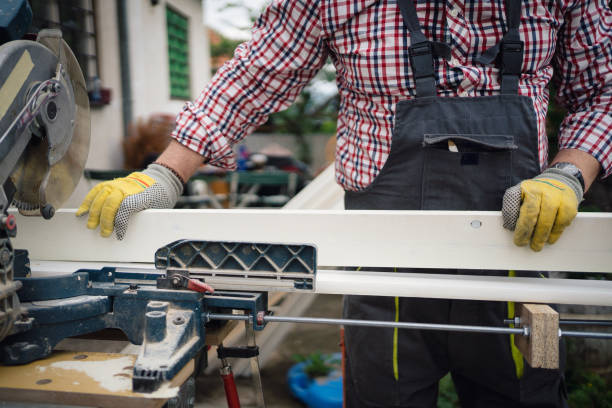
Before you start cutting metal roofing, it’s essential to prepare your workspace and metal roofing sheets properly. A clean, well-organized workspace will help ensure a smooth cutting process, while accurately measured and marked metal sheets will result in precise cuts and minimal waste.
In this section, we will discuss the importance of setting up a workbench and clamping, as well as measuring and marking guidelines on your metal sheets.
Workbench and Clamping
A workbench serves as a flat surface for cutting, while clamping is a device used to secure objects in place during the cutting process. To utilize a workbench and clamp for cutting metal roofing, follow these steps:
- Place the metal roofing on top of the workbench and outline the pattern using a tape measure and pencil.
- Clamp the metal roofing in place.
- Make sure your workbench is stable and that the clamps are firmly attached to the workbench to ensure a safe cutting process.
When utilizing a workbench and clamp for cutting metal roofing, it is imperative to follow these safety measures.
- Wear protective gear such as safety glasses, gloves, and a dust mask.
- Verify that the workbench and clamp are firmly secured to the surface.
- Ensure that the metal roofing is securely clamped in place.
By following these safety measures, you can ensure a stable and secure cutting process, minimizing the risk of accidents or damage to your metal roofing panels.
Measuring and Marking Guidelines
Accurately measuring and marking guidelines on metal sheets is crucial for ensuring precise cuts and reducing material waste. To measure and mark guidelines for cutting metal roofing, follow these steps:
- Use a tape measure to plot out the starting and ending points of the cut.
- Use a combination square to ensure the line is straight and accurate.
- Use a marker to mark the guideline on the metal sheet.
By following these steps, you can ensure that your cuts are precise and minimize material waste.
When using a combination square and marker, it is advisable to draw the line slowly and evenly. Additionally, it is prudent to check the line with the combination square to ensure its accuracy. By following these guidelines, you can ensure that your metal roofing panels are cut accurately and efficiently, leading to a better overall project outcome.
Safety Measures When Cutting Metal Roofing
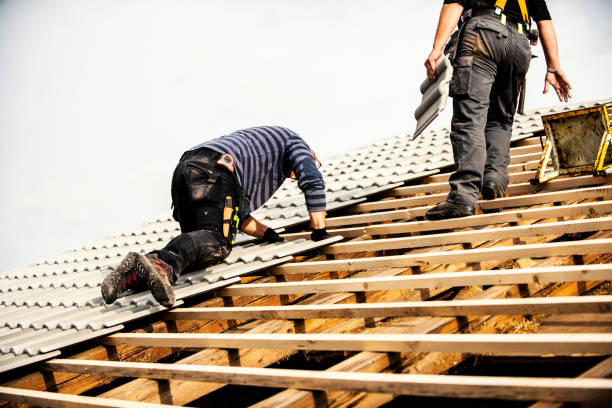
Safety is of the utmost importance when cutting metal roofing. Not only can improperly cut metal roofing lead to leaks and other issues, but it can also result in serious injury if safety measures are not taken.
In this section, we will discuss the importance of personal protective equipment and safe cutting techniques when working with metal roofing.
Personal Protective Equipment
When cutting metal roofing, it is essential to wear personal protective equipment to safeguard against potential injuries. Here are some important items to wear.
- Long sleeves and pants
- Thick work gloves
- Hard boots
- Appropriate face and eye protection
- Cut and puncture-resistant gloves
- Gloves that will not melt due to the heat generated when cutting metal
Gloves serve as a protective measure against potential injury, while safety goggles help shield your eyes from metal dust and flying debris. A dust mask can also help protect your lungs from inhaling harmful metal dust that may be generated during the cutting process.
By wearing the proper personal protective equipment, you can minimize the risk of injury and ensure a safe and efficient cutting process.
Safe Cutting Techniques
In addition to wearing personal protective equipment, it’s essential to employ safe cutting techniques when working with metal roofing. Depending on the tools you are using, there might be specific safety precautions you need to follow. For example, when using a circular saw, it’s important to abstain from using high speed and to don the appropriate safety gear. Similarly, when using an angle grinder, it’s crucial to maintain a 45-degree angle and progress slowly.
By following the recommended safe cutting techniques for each tool, you can minimize the risk of accidents and ensure a smooth cutting process. Moreover, it’s always a good idea to double-check your measurements and guidelines before making a cut, as this will help prevent mistakes and minimize waste.
By combining safe cutting techniques with proper personal protective equipment, you can successfully cut metal roofing panels with confidence and precision.
Step-by-Step Guide to Cutting Metal Roofing Panels
Now that you’re familiar with the tools, workspace preparation, and safety measures required for cutting metal roofing, it’s time to dive into the step-by-step process. In this section, we will provide a clear guide on how to cut metal roofing panels, whether you need to make straight cuts or curved/specialty cuts.
By following these steps and using the right tools for the job, you can ensure a successful outcome for your project.
Straight Cuts with Circular Saw or Power Shears
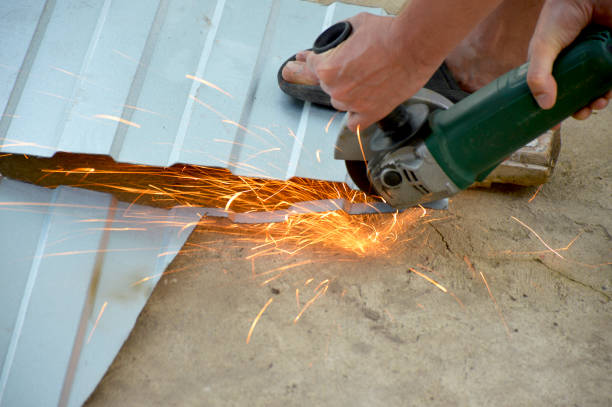
To make straight cuts in metal roofing panels, you can use either a circular saw or power shears. Circular saws are ideal for making long, straight cuts through multiple metal roofing panels, while power shears are more suited for cutting individual panels quickly and efficiently. When using a circular saw or power shears, ensure that the blade is adjusted to a depth that allows it to cut through the lower parts of the corrugation and operate the shears at a slow speed.
When making straight cuts on metal roofing panels, follow these techniques:
- Cut slowly and carefully along the straight guidelines that have been marked on the panels.
- Use the appropriate tool for the job.
- This will help ensure that your cuts are accurate and clean, minimizing the risk of mistakes and waste.
By following these techniques, you can make precise straight cuts on your metal roofing panels with ease.
Curved or Specialty Cuts with Tin Snips or Angle Grinder
For curved or specialty cuts, such as cutting around obstacles or creating unique shapes, tin snips or an angle grinder are your best options. Tin snips are ideal for making short, precise cuts on individual metal sheets, while an angle grinder is more versatile and can be used for a range of cutting tasks. To create openings for pipe boots and vents, follow these steps:
- Trace the circle or square where the opening needs to be.
- Initiate a pilot hole in the center of the traced shape with a drill bit.
- Use tin snips to cut along the guideline and create the opening.
When using an angle grinder, maintain a 45-degree angle and progress slowly. Tin snips should be held on one side to ensure a straight cut. Both tools are capable of easily slicing through 26 or 29 gauge metal panels, making them excellent choices for curved or specialty cuts on metal roofing.
By following these techniques and using the appropriate tool for the job, you can create custom cuts and unique shapes on your metal roofing panels with confidence.
Installation Considerations After Cutting
Once you’ve successfully cut your metal roofing panels, there are a few important installation considerations to keep in mind. Proper handling, storage, and disposal of cut materials are crucial for ensuring a smooth installation process and minimizing the risk of accidents or damage.
In addition, it’s important to ensure that the cut edges of corrugated metal roofing are smooth and free of burrs to avoid potential injury during installation. To handle cut materials safely, always wear protective gloves and be cautious of sharp edges. Store cut metal roofing panels in a dry, secure location to prevent damage or corrosion. Dispose of any metal scraps or debris in accordance with applicable regulations to ensure a safe and clean work environment.
By following these guidelines, you can help ensure a smooth installation process and a long-lasting, durable metal roof, which is one of the many advantages of metal roofs.
Summary
In conclusion, cutting metal roofing panels is a skill that can be mastered with the right knowledge, tools, and techniques. By choosing the appropriate cutting tool, preparing your workspace, following safety measures, and using the step-by-step guide provided in this blog post, you can cut metal roofing panels with confidence and precision. Whether you’re a DIY enthusiast or a professional in the construction industry, these tips and techniques will help you achieve a durable, weather-resistant, and visually appealing metal roof for any project.
If you found this article helpful, check out our site, Amtek Roofing LLC and our roofing services offered, especially our metal roofing page.
Frequently Asked Questions
What is the easiest way to cut corrugated metal roofing?
For the easiest way to cut corrugated metal roofing, tin snips are your best bet. This manual, handheld tool is perfect for smaller pieces of roofing and provides great precision in tight or angled spaces.
With tin snips, you can effortlessly cut out pieces from the center of your metal roofing with ease.
How to cut tin roofing?
To accurately cut tin roofing, first take measurements of the roof area and transfer them to the roofing sheets. Place the sheets on a flat surface, mark the areas that need cutting, secure the sheets and then use the appropriate tools such as tin snips to make your cuts.
Following these steps will ensure that you get accurate and clean cuts for your project.
How to cut tin?
To cut tin, hold the tin firmly in place and use either tin snips or an aviation snip to score a line along the intended cut. To begin, use the up-cut motion of the snips or snips to create a groove for the blade to follow.
Then switch to the left or right-cut motion to complete the cut. Finally, bend the metal back to snap off any jagged edges for a clean cut.
What are the best tools for cutting metal roofing?
When it comes to cutting metal roofing, tin snips, circular saws, angle grinders, and power shears are considered the best tools for the job. All of these tools can make quick work of metal roofing material, so take some time to decide which one is the right fit for your project.
How do I prepare my workspace for cutting metal roofing?
To get your workspace ready for cutting metal roofing, make sure the area is clean, your table is firm, and that you have accurately measured and marked the metal pieces.
Ensure that you have the right tools for the job, such as a metal shear, a drill, and a saw. Make sure that you have the right safety gear, such as gloves, goggles, and a face mask. Finally, double-check the spelling.


